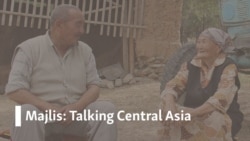Years before there was "fake news," there were official statistics from Turkmenistan.
Figures released by the Turkmen government have continually stretched the boundaries of belief and all-too-often there was no reason to believe they were accurate.
The government website Neutrality.gov.tm has just posted a new population figure for the country -- 6.2 million -- and once again the reaction is "what?"
The webpage presents basic facts about Turkmenistan and is intended as a primer for visitors the government hopes will attend a conference called The Politics of Neutrality and its Role in Ensuring International Peace, Security, and Sustainable Development, to be held in December.
For those of you familiar with Turkmenistan, I could probably end the story here.
But for the benefit of those who have not been following Turkmenistan for many years, on December 12 this year Turkmenistan will mark 25 years since the UN voted to recognize the country as a neutral state.
I would like to explain what that means, but after 25 years (and I wrote about it when it happened) I am still not sure exactly what neutrality means for Turkmenistan.
Under this status of "positive neutrality," Turkmenistan has become an isolationist country, sealing itself off from the outside world, which is why it is easy for the government to claim huge successes without anyone being sure how much exaggeration there is in the reported achievements.
Now we are told there are 6.2 million people living in Turkmenistan.
Just before the Soviet Union disintegrated and Turkmenistan became independent, Soviet authorities recorded the population of the Soviet Socialist Republic of Turkmenia as being 3.7 million people.
After that, all the figures on Turkmenistan's population came from the country's National Institute of State Statistics and Information, which put the population at 4.5 million in 1995, at 5.37 million in 2000, at 5.79 million in 2002, and 6 million in April 2003, when the government press service reported the birth of citizen No. 6 million (and said the population had increased by 1 million people since 1999, a 20 percent increase in four years), and so on, and so on. In March 2006, the institute reported that the population had reached 6.79 million.
When first President Saparmurat Niyazov died in December 2006, population figures were no longer reported publicly. Turkmenistan conducted a census in 2012 but never revealed the results.
An Internet search will show a range of estimates by various sources that go from 5 million to 6 million people. But no one really knows.
Turkmenistan's economy is in a total free fall, as the food scarcities, unpaid wages, skyrocketing unemployment, lack of hard currency, and massive inflation will show.
But curiously, official figures provided by the government show robust growth in the country.
Testimony from an increasingly frustrated population that escapes the state cage indicates that the economic situation is dire, certainly not ideal conditions for young couples to think about having large families.
And there was also a report in May 2019 from RFE/RL's Turkmen Service, known locally as Azatlyk, that quoted an official as saying nearly 1.9 million people had left the country since 2008 and that the real size of the population was closer to 3.3 million.
Indeed, there are many reports of officials at Turkmenistan international airport in Ashgabat refusing to let people leave the country.
Azatlyk just had such a report, in which people were being refused entry to planes despite having tickets and valid visas to the countries they were to fly to.
No reason is ever given to those denied boarding, which perhaps lends credence to the report about the massive exodus of Turkmen from the country in the last 12 years.
Still, it is quite impossible to know for sure how many people live in Turkmenistan at the moment.
Another dubious claim on the list of basic facts on the Neutrality.gov.tm website states: "There are more than 100 nations (nationalities) living in the country."
No way.
I traveled extensively around Turkmenistan in 1992-93 to all corners of the country. There were certainly far less than 100 different nationalities living in Turkmenistan at that time, and there is no possibility there are that many living there now.
If anything, the policies of the "Turkmenization of Turkmenistan" have caused a significant out-migration of non-Turkmen people in the last 20 years.
So that claim is false, and likely so too is the claim about the population being 6.2 million. The webpage provides no rationale or supporting evidence for this figure.
Of course, anyone familiar with Turkmenistan's current authoritarian president, Gurbanguly Berdymukhammedov, will have seen him show off his many alleged talents for state media.
So amazing is Berdymukhammedov that he alone might be counted by state officials as 3 million people.
The views expressed in this blog post do not necessarily reflect those of RFE/RL









